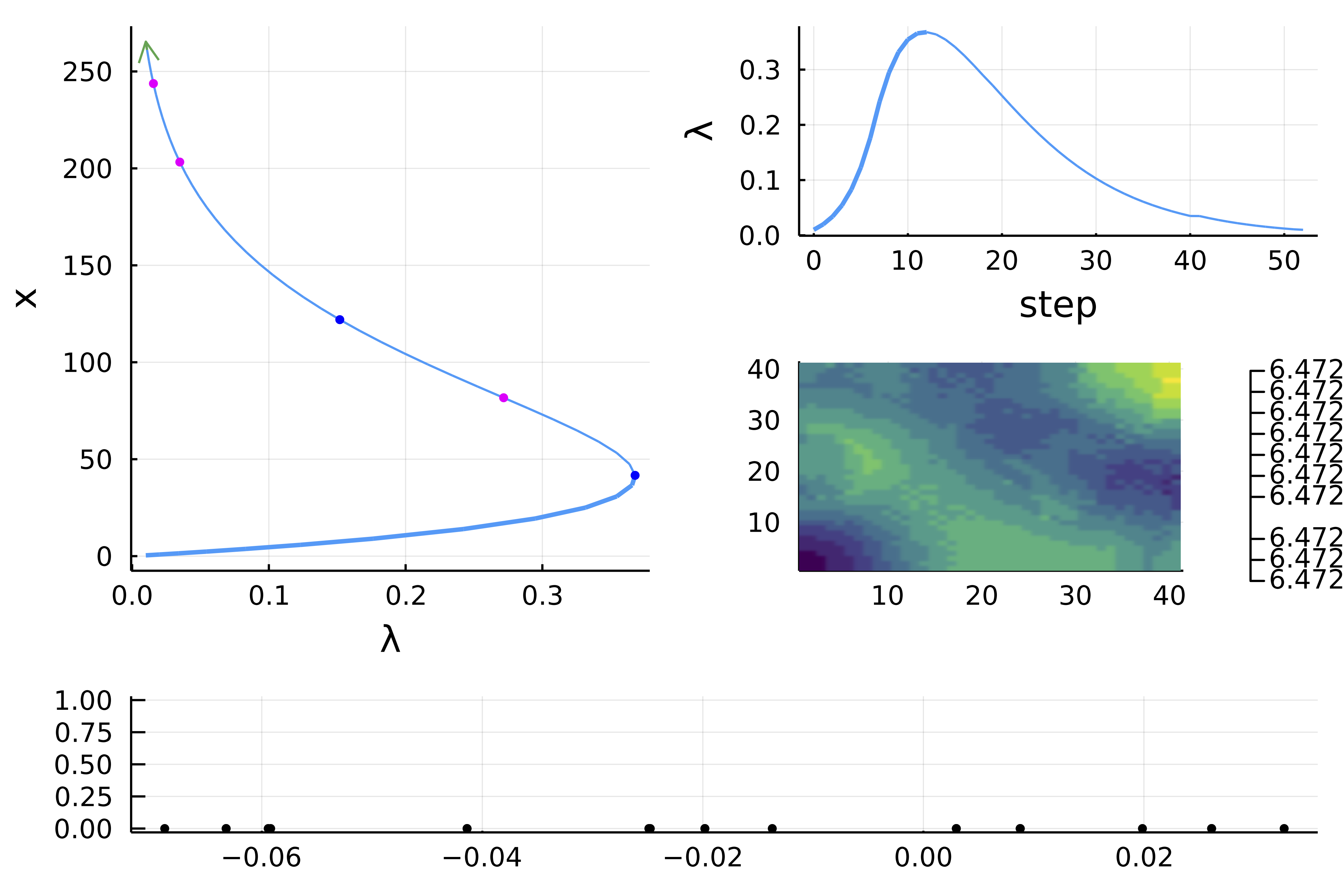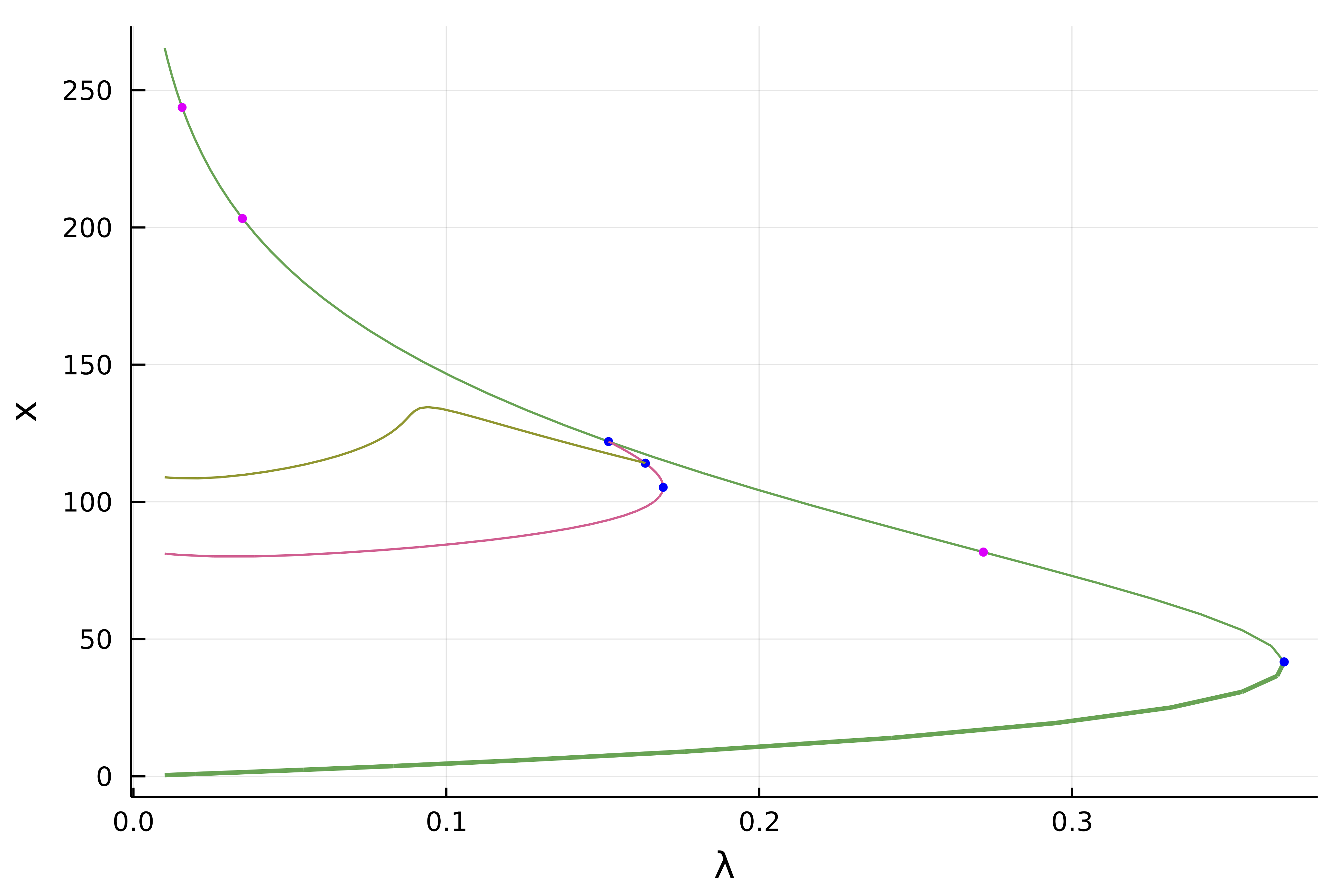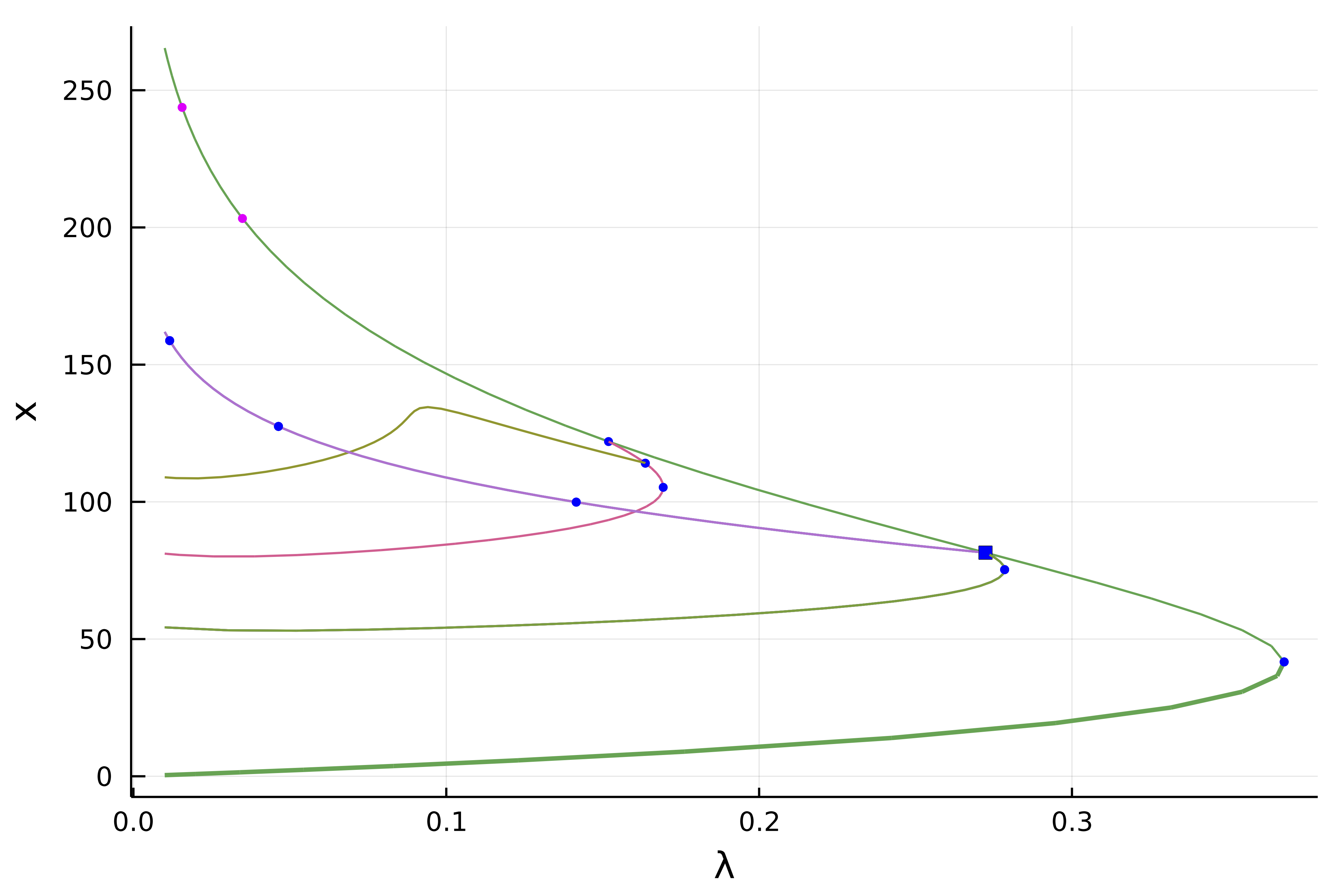🟡 2d Bratu–Gelfand problem with Gridap.jl
We re-consider the problem of Mittelmann treated in the previous tutorial but using a finite elements method (FEM) implemented in the package Gridap.jl.
Recall that the problem is defined by solving
\[\Delta u +NL(\lambda,u) = 0\]
with Neumann boundary condition on $\Omega = (0,1)^2$ and where $NL(\lambda,u)\equiv-10(u-\lambda e^u)$.
We start by installing the package GridapBifurcationKit.jl. Then, we can import the different packages:
using Revise, Plots
using Gridap
using Gridap.FESpaces
using GridapBifurcationKit
using BifurcationKit
# custom plot function to deal with Gridap
plotgridap!(x; k...) = (n=isqrt(length(x));heatmap!(reshape(x,n,n); color=:viridis, k...))
plotgridap(x; k...) =( plot();plotgridap!(x; k...))We are now ready to specify the problem using the setting of Gridap.jl: it allows to write the equations very closely to the mathematical formulation:
# discretisation
n = 40
domain = (0, 1, 0, 1)
cells = (n,n)
model = CartesianDiscreteModel(domain,cells)
# function spaces
order = 1
reffe = ReferenceFE(lagrangian, Float64, order)
V = TestFESpace(model, reffe, conformity=:H1,)#dirichlet_tags="boundary")
U = TrialFESpace(V)
Ω = Triangulation(model)
degree = 2*order
const dΩ = Measure(Ω, degree) # we make it const because it is used in res
# nonlinearity
NL(u) = exp(u)
# residual
res(u,p,v) = ∫( -∇(v)⋅∇(u) - v ⋅ (u - p.λ ⋅ (NL ∘ u)) * 10 )*dΩ
# jacobian of the residual
jac(u,p,du,v) = ∫( -∇(v)⋅∇(du) - v ⋅ du ⋅ (1 - p.λ * ( NL ∘ u)) * 10 )*dΩ
# 3rd and 4th derivatives, used for aBS
d2res(u,p,du1,du2,v) = ∫( v ⋅ du1 ⋅ du2 ⋅ (NL ∘ u) * 10 * p.λ )*dΩ
d3res(u,p,du1,du2,du3,v) = ∫( v ⋅ du1 ⋅ du2 ⋅ du3 ⋅ (NL ∘ u) * 10 * p.λ )*dΩ
# example of initial guess
uh = zero(U)
# model parameter
par_bratu = (λ = 0.01,)
# problem definition
prob = GridapBifProblem(res, uh, par_bratu, V, U, (@optic _.λ);
jac = jac,
d2res = d2res,
d3res = d3res,
plot_solution = (x,p; k...) -> plotgridap!(x; k...))We can call then the newton solver:
optn = NewtonPar(eigsolver = EigArpack())
sol = newton(prob, NewtonPar(optn; verbose = true))which gives
┌─────────────────────────────────────────────────────┐
│ Newton step residual linear iterations │
├─────────────┬──────────────────────┬────────────────┤
│ 0 │ 2.4687e-03 │ 0 │
│ 1 │ 1.2637e-07 │ 1 │
│ 2 │ 3.3833e-16 │ 1 │
└─────────────┴──────────────────────┴────────────────┘In the same vein, we can continue this solution as function of $\lambda$:
opts = ContinuationPar(p_max = 40., p_min = 0.01, ds = 0.01,
max_steps = 1000, detect_bifurcation = 3, newton_options = optn, nev = 20)
br = continuation(prob, PALC(tangent = Bordered()), opts;
plot = true,
verbosity = 0,
)We obtain:
julia> br
┌─ Curve type: EquilibriumCont
├─ Number of points: 56
├─ Type of vectors: Vector{Float64}
├─ Parameter λ starts at 0.01, ends at 0.01
├─ Algo: PALC
└─ Special points:
- # 1, bp at λ ≈ +0.36787944 ∈ (+0.36787944, +0.36787944), |δp|=1e-12, [converged], δ = ( 1, 0), step = 13
- # 2, nd at λ ≈ +0.27234314 ∈ (+0.27234314, +0.27234328), |δp|=1e-07, [converged], δ = ( 2, 0), step = 21
- # 3, bp at λ ≈ +0.15185452 ∈ (+0.15185452, +0.15185495), |δp|=4e-07, [converged], δ = ( 1, 0), step = 29
- # 4, nd at λ ≈ +0.03489122 ∈ (+0.03489122, +0.03489170), |δp|=5e-07, [converged], δ = ( 2, 0), step = 44
- # 5, nd at λ ≈ +0.01558733 ∈ (+0.01558733, +0.01558744), |δp|=1e-07, [converged], δ = ( 2, 0), step = 51
- # 6, endpoint at λ ≈ +0.01000000, 
Computation of the first branches
Let us now compute the first branches from the bifurcation points. We start with the one with 1d kernel:
br1 = continuation(br, 3,
setproperties(opts; ds = 0.005, dsmax = 0.05, max_steps = 140, detect_bifurcation = 3);
verbosity = 3, plot = true, nev = 10,
usedeflation = true,
callback_newton = BifurcationKit.cbMaxNorm(100),
)We also compute the branch from the first bifurcation point on this branch br1:
br2 = continuation(br1, 3,
setproperties(opts;ds = 0.005, dsmax = 0.05, max_steps = 140, detect_bifurcation = 3);
verbosity = 0, plot = true, nev = 10,
usedeflation = true,
callback_newton = BifurcationKit.cbMaxNorm(100),
)
plot(br, br1, br2)We get:

Finally, we compute the branches from the 2d bifurcation point:
br3 = continuation(br, 2,
setproperties(opts; ds = 0.005, dsmax = 0.05, max_steps = 140, detect_bifurcation = 0);
verbosity = 0, plot = true,
usedeflation = true,
verbosedeflation = false,
callback_newton = BifurcationKit.cbMaxNorm(100),
)
plot(br, br1, br2, br3...)